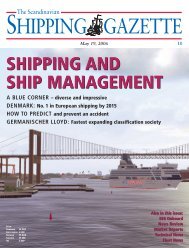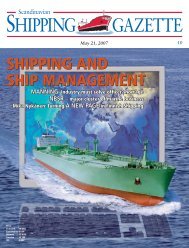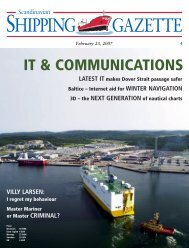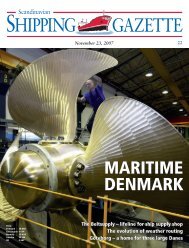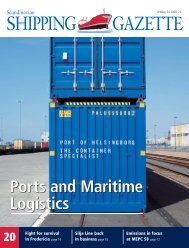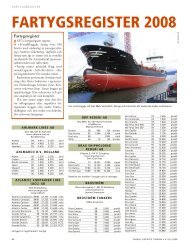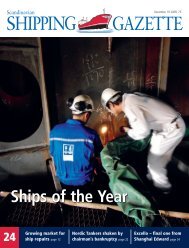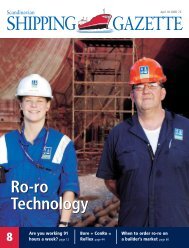SSG No 20 - Shipgaz
SSG No 20 - Shipgaz
SSG No 20 - Shipgaz
You also want an ePaper? Increase the reach of your titles
YUMPU automatically turns print PDFs into web optimized ePapers that Google loves.
Jens Grabbe<br />
fleet news<br />
Editor: Pär-Henrik Sjöström ~ Phone: +358 2 242 62 50 ~ E-mail: par-henrik@shipgaz.com<br />
New T-class<br />
for Maersk Line<br />
The Maersk Tanjong is the first in a new<br />
series of container carriers from Daewoo to<br />
the A. P. Møller-Mærsk Group. The T-class<br />
is a standard type from the Korean Shipbuilder<br />
Daewoo Shipbuilding and Marine<br />
Engineering and has been delivered from<br />
their facilities at Okpo as hull no. 4117.<br />
The ship is a 332 metres long and 43<br />
metres beam container carrier with an official<br />
capacity of 8,043 TEUs of which 750<br />
containers can be reefers. All at a deadweight<br />
of 107,500 DWT. These measures<br />
correspond with the A-class vessels from<br />
Odense Steel Shipyard.<br />
Express service<br />
The first of the T-class vessels has been<br />
deployed on the AE10-service (Asia–<br />
Europe) running from Shanghai via Ningbo,<br />
Xiamen, Yantian and Hong Kong to<br />
Suez, Algeciras, Felixstowe, Zeebrügge<br />
and Dunkerque. The service is an express<br />
service handling the rising export of goods<br />
from China to European consumers.<br />
The super-containerships in the E-class<br />
run another express export service from<br />
China called AE7, where the huge vessels<br />
are often fully loaded on departure<br />
from China. It is not unusual that an Eclass<br />
vessel arrives at Algeciras (first port<br />
of discharge) with a total cargo of 160,000<br />
tons and discharges some 1<strong>20</strong>,000 tons for<br />
distribution to Africa, South America and<br />
<strong>No</strong>rth America.<br />
The new T-class vessels are powered by<br />
Wärtsilä 12RT-flex96C engines developing<br />
some 68,640 kW at a service speed of<br />
around 25 knots.<br />
bent mikkelsen<br />
The Maersk Tanjong heading for Hamburg<br />
on her maiden voyage.<br />
The Fennia was built in 1966 and was later renamed the Casino express.<br />
Sad end for the Fennia<br />
The old passenger/car ferry Casino Express,<br />
now renamed C Express, hit the headlines<br />
after the Finnish Environment Institute<br />
SYKE issued a transport ban due to suspicions<br />
about scrapping plans. By mid-October<br />
the vessel was still laid up in the port of<br />
Vasa as the new owner Attar Construction<br />
Ltd was waiting for the transport ban to be<br />
reversed.<br />
This is a sad end for an exceptionally<br />
long career in the Baltic Sea. Built in 1966<br />
as Fennia by Öresundsvarvet AB in Landskrona,<br />
Sweden, she was back then the largest<br />
and most innovative ferry in the rapidly<br />
expanding traffic between Finland and<br />
Sweden. Her owner Oy Siljarederiet Ab<br />
introduced her on the route between Turku<br />
(Åbo), Åland and the new ferry port Värtan<br />
of Stockholm. Her size was regarded sensational<br />
and both her cargo and passenger<br />
capacity were considerably larger than on<br />
the other ferries trading across the Sea of<br />
Åland.<br />
Laid up<br />
Even though new and larger ferries were<br />
introduced in an accelerating pace, the Fennia<br />
continued in Silja Line’s traffic throughout<br />
the 1970’s and she was finally laid up<br />
at Turku in autumn 1982. After some short<br />
charters she entered service with Jakob<br />
Lines in 1984 and moved northwards to the<br />
Gulf of Bothnia. With some exceptions the<br />
ferry spent the rest of her active time there.<br />
Two years later she was transferred to the<br />
Rederi Ab Sally-owned Vasabåtarna, and<br />
her original appearance was dramatically<br />
changed during an extensive refit in Turku.<br />
After Silja’s takeover of the Sally-company<br />
she was back in Silja’s fleet.<br />
The Fennia was a pioneer also in the ferry<br />
traffic between Scandinavia and the Baltic<br />
states. In 1992 she was on charter to a<br />
ferry service between <strong>No</strong>rrköping and Riga.<br />
In 1993 the Fennia returned to the Quark<br />
(Kvarken). Summer 1999 was the very last<br />
season in this area in Silja Line’s colours,<br />
as the company laid down its routes across<br />
the Quark after the abolishment of the taxfree<br />
trade.<br />
In <strong>20</strong>01 the new company RG Line<br />
bought the vessel and she re-entered service<br />
between Vasa and Umeå, now renamed the<br />
Casino Express. In <strong>20</strong>05 she was replaced<br />
by the ro-pax ferry RG I and after completing<br />
the summer season in <strong>20</strong>05 she has<br />
been laid up at Vasa.<br />
pär-henrik sjöström<br />
72 sCanDInaVIan sHIPPInG GaZeTTe • OCTOber 26, <strong>20</strong>07




